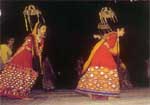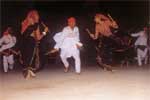|
Link Back To Madhu's Home Page
Link Back To Hindu Festivals
Link Back To Durga Puja
Link Back To Dushehra
Navaratri:
Navratri or the Festival of Nine Nights from
Ashvin Sud 1 to 9 is devoted to 'Shakti' or Divine Mother. She represents prakriti, counterpart of purusha
jointly making possible the creation of the world according to the religious ideology of Goddess worship. Such worships
were prevalent in India even before
the advent of the Aryans, who adopted it as a religious practice. References in vedas and puranas confirm this
opinion. This festival is essentially religious in nature. It is celebrated with true devotion in the various temples dedicated
to the Mother.
The most common form of public celebration
is the performance of garbaa or daandia-raas, Gujarat's popular folk-dance, late throughout the nights of these nine days in public squares, open grounds
and streets. Females wear ethnic Chania Choli and Males wear Dhoti-Kurta and enjoy garbaa and daandiyaa raas (dance) the whole
Night. The participants move round in a circle around a mandvi (garbo), a structure to hold earthen lamps filled with
water and to house the image or idol of mother goddess. A betel nut and a silver coin are placed within the pot, called a
kumbh, on top of which a coconut has also been placed. Pandals are erected over these madvis and decorated with asopalav,
date palm leaves, flowers and electric light. As the dancers whirl around the pot, a singer and a drummer provide the musical
accompaniment. The participants clap in a steady rhythm. The dance usually starts slowly. It gets faster and faster as the
music too gets more rapid until the dance abruptly comes to a halt. There is a pause for a while and the dance commences once
again, the singer leading with a new song.
Another dance which is also a feature of Navaratri
is the daandiaa-raas or ‘stick’ dance, in which men and women join the dance circle, holding small polished
sticks or daandiaas. As they whirl to the intoxicating rhythm of the dance, men and women strike the daandiaas together, adding
to the joyous atmosphere. So popular are the garbaa and the daandiaa-raas that competitions are held to assess
the quality of the dancing. Prizes are given to those judged to be the best. The costumes worn for the dances are traditional
and alive with colour. The dances usually commence late in the night and continue until early morning, testifying to their
great popularity.


Dandiya Raas or Garba Raas are often seen in Hindi movies. Following are a few examples of songs
to which Raas was danced:
Sapne Saajan Ke - title song
Hum Dil De Chuke Sanam - dholi taro
Aa Ab Laut Chalen - yahi hai pyar
Lajja - saajan ke ghar jaanaa hai
Suhaag - o sheronwali bigde bana de
Falguni Pathak Raas Songs:
maine paayal hai chhankaayi
mar jaani jhaanjhar bol padi
sajna sajna bole kangana saari raat
Click on links below for Gujrati Daandiyaa and Garbaa Raas songs:
Gujrati Dandiya Raas Songs 1
Gujrati Dandiya Raas Songs 2
Gujrati Dandiya Raas Songs 3
|

